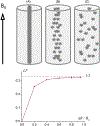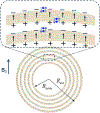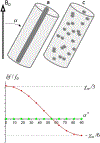Effects of biological tissue structural anisotropy and anisotropy of magnetic susceptibility on the gradient echo MRI signal phase: theoretical background
- PMID: 27862452
- PMCID: PMC6375105
- DOI: 10.1002/nbm.3655
Effects of biological tissue structural anisotropy and anisotropy of magnetic susceptibility on the gradient echo MRI signal phase: theoretical background
Abstract
Quantitative susceptibility mapping is a potentially powerful technique for mapping tissue magnetic susceptibility from gradient recalled echo (GRE) MRI signal phase. In this review, we present up-to-date theoretical developments in analyzing the relationships between GRE signal phase and the underlying tissue microstructure and magnetic susceptibility at the cellular level. Two important phenomena contributing to the GRE signal phase are at the focus of this review - tissue structural anisotropy (e.g. cylindrical axonal bundles in white matter) and magnetic susceptibility anisotropy. One of the most intriguing and challenging problems in this field is calculating the so-called Lorentzian contribution to the phase shift induced by the local environment - magnetized tissue structures that have dimensions smaller than the imaging voxel (e.g. cells, cellular components, blood capillaries). In this review, we briefly discuss a "standard" approach to this problem, based on introduction of an imaginary Lorentzian cavity, as well as a more recent method - the generalized Lorentzian tensor approach (GLTA) - that is based on a statistical approach and a direct solution of the magnetostatic Maxwell equations. The latter adequately accounts for both types of anisotropy: the anisotropy of magnetic susceptibility and the structural tissue anisotropy. In the GLTA the frequency shift due to the local environment is characterized by the Lorentzian tensor L^, which has a substantially different structure than the susceptibility tensor χ^. While the components of χ^ are compartmental susceptibilities "weighted" by their volume fractions, the components of L^ are weighted by specific numerical factors depending on tissue geometrical microsymmetry. In multi-compartment structures, the components of the Lorentzian tensor also depend on the compartmental relaxation properties, hence the MR pulse sequence settings. Copyright © 2016 John Wiley & Sons, Ltd.
Keywords: generalized Lorentzian tensor approach; magnetic susceptibility; phase contrast; quantitative susceptibility mapping; white matter.
Copyright © 2016 John Wiley & Sons, Ltd.
Figures











Similar articles
-
Lorentzian effects in magnetic susceptibility mapping of anisotropic biological tissues.J Magn Reson. 2018 Jul;292:129-136. doi: 10.1016/j.jmr.2018.04.014. Epub 2018 Apr 26. J Magn Reson. 2018. PMID: 29730126 Free PMC article. Review.
-
Generalized Lorentzian Tensor Approach (GLTA) as a biophysical background for quantitative susceptibility mapping.Magn Reson Med. 2015 Feb;73(2):757-64. doi: 10.1002/mrm.25538. Epub 2014 Nov 26. Magn Reson Med. 2015. PMID: 25426775 Free PMC article.
-
Magnetic susceptibility induced white matter MR signal frequency shifts--experimental comparison between Lorentzian sphere and generalized Lorentzian approaches.Magn Reson Med. 2014 Mar;71(3):1251-63. doi: 10.1002/mrm.24762. Magn Reson Med. 2014. PMID: 23637001 Free PMC article.
-
Accelerated mapping of magnetic susceptibility using 3D planes-on-a-paddlewheel (POP) EPI at ultra-high field strength.NMR Biomed. 2017 Apr;30(4). doi: 10.1002/nbm.3620. Epub 2016 Oct 20. NMR Biomed. 2017. PMID: 27763692
-
Susceptibility tensor imaging (STI) of the brain.NMR Biomed. 2017 Apr;30(4):10.1002/nbm.3540. doi: 10.1002/nbm.3540. Epub 2016 Apr 27. NMR Biomed. 2017. PMID: 27120169 Free PMC article. Review.
Cited by
-
Learn Less, Infer More: Learning in the Fourier Domain for Quantitative Susceptibility Mapping.Front Neurosci. 2022 Feb 16;16:837721. doi: 10.3389/fnins.2022.837721. eCollection 2022. Front Neurosci. 2022. PMID: 35250469 Free PMC article.
-
Quantifying myelin in crossing fibers using diffusion-prepared phase imaging: Theory and simulations.Magn Reson Med. 2021 Nov;86(5):2618-2634. doi: 10.1002/mrm.28907. Epub 2021 Jul 13. Magn Reson Med. 2021. PMID: 34254349 Free PMC article.
-
Substantia Nigra Volume Dissociates Bradykinesia and Rigidity from Tremor in Parkinson's Disease: A 7 Tesla Imaging Study.J Parkinsons Dis. 2020;10(2):591-604. doi: 10.3233/JPD-191890. J Parkinsons Dis. 2020. PMID: 32250317 Free PMC article.
-
Biophysically motivated efficient estimation of the spatially isotropic component from a single gradient-recalled echo measurement.Magn Reson Med. 2019 Nov;82(5):1804-1811. doi: 10.1002/mrm.27863. Epub 2019 Jul 10. Magn Reson Med. 2019. PMID: 31293007 Free PMC article.
-
Quantitative Susceptibility Mapping: MRI at 7T versus 3T.J Neuroimaging. 2020 Jan;30(1):65-75. doi: 10.1111/jon.12669. Epub 2019 Oct 18. J Neuroimaging. 2020. PMID: 31625646 Free PMC article.
References
-
- Zhong K, Leupold J, von Elverfeldt D, Speck O. The molecular basis for gray and white matter contrast in phase imaging. Neuroimage 2008; 40(4): 1561–1566. - PubMed
-
- Marques JP, Maddage R, Mlynarik V, Gruetter R. On the origin of the MR image phase contrast: an in vivo MR microscopy study of the rat brain at 14.1 T. Neuroimage 2009; 46(2): 345–352. - PubMed
-
- Abduljalil AM, Schmalbrock P, Novak V, Chakeres DW. Enhanced gray and white matter contrast of phase susceptibility-weighted images in ultra-high-field magnetic resonance imaging. J. Magn. Reson. Imaging 2003; 18(3): 284–290. - PubMed
Publication types
MeSH terms
Grants and funding
LinkOut - more resources
Full Text Sources
Other Literature Sources

